|
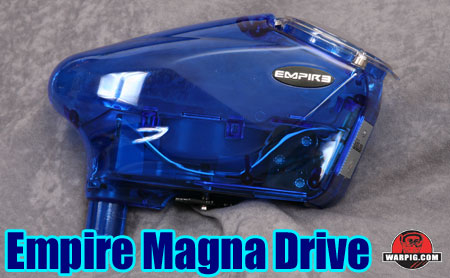
Empire Magna Drive Loader
by Bill Mills - Photos by Dawn Mills - June 08
Page1 Page2
 The Magna Drive Loader was added to the Empire Product line after its debut at the 2007 Paintball World Cup. Although it has several unique design features, its heritage to the HALO and Reloader loaders is clearly evident – not surprising as both brands are owned by the company that produces the Empire product line, KEE Action Sports. The Magna Drive Loader stands as the next generation forward of the HALO catch-up forced-feed loader design. The Magna Drive Loader was added to the Empire Product line after its debut at the 2007 Paintball World Cup. Although it has several unique design features, its heritage to the HALO and Reloader loaders is clearly evident – not surprising as both brands are owned by the company that produces the Empire product line, KEE Action Sports. The Magna Drive Loader stands as the next generation forward of the HALO catch-up forced-feed loader design.
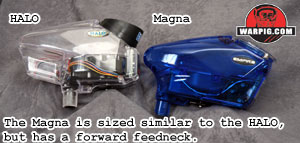 Externally the Magna Drive Loader is similar in height to a HALO, and shares the same general styling, with similar curves. Its component layout is quite a bit different though. The Magna Drive has its feedneck up front, batteries in the back, and feed mechanism in the middle, as opposed to the HALO design that puts batteries up front, neck in the middle and drive system in the back. Although this configuration makes the loader itself less balanced, it is designed to balance better on a marker, shifting the marker's center of gravity back closer to the player's hand. Externally the Magna Drive Loader is similar in height to a HALO, and shares the same general styling, with similar curves. Its component layout is quite a bit different though. The Magna Drive has its feedneck up front, batteries in the back, and feed mechanism in the middle, as opposed to the HALO design that puts batteries up front, neck in the middle and drive system in the back. Although this configuration makes the loader itself less balanced, it is designed to balance better on a marker, shifting the marker's center of gravity back closer to the player's hand.
The Magna Drive Loader body is comprised of two polycarbonate shell halves. An advanced polymer that can often literally stop bullets, this has become the de-facto standard material for high-end loader bodies, and is common to the HALO/reloader product line.
 The Magna Drive is powered by six “AA” sized batteries, delivering 9-volts of power with the capacity for far more amperage (necessary for fast motor reactions) than a rectangular 9-volt (or even pair of 9-volt) batteries. The Magna Drive is powered by six “AA” sized batteries, delivering 9-volts of power with the capacity for far more amperage (necessary for fast motor reactions) than a rectangular 9-volt (or even pair of 9-volt) batteries. 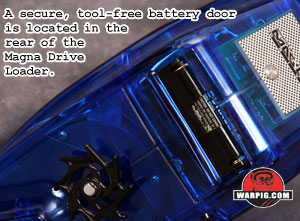 The new body design does away with the need to pack a phillips screwdriver for battery changes. Instead, a sliding door in the lower rear of the loader body provides access to the battery compartment. During testing for review, removal and installation of batteries also was less cumbersome than with the original HALO body shell design, with less attention needing to be paid to wire placement. The new body design does away with the need to pack a phillips screwdriver for battery changes. Instead, a sliding door in the lower rear of the loader body provides access to the battery compartment. During testing for review, removal and installation of batteries also was less cumbersome than with the original HALO body shell design, with less attention needing to be paid to wire placement.
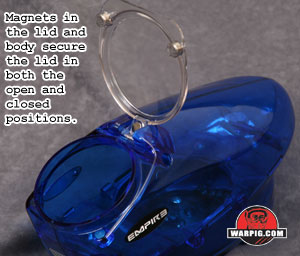 The loader's lid is springless, following the design found in the Reloader II hopper. Rare earth magnets in the lid and the hopper body serve both to hold the lid closed, and hold it in the all the way open position. This gives it quite a different feel than a spring-flapped loader lid, and eliminates the hassles of pre-tensioning a lid spring when re-assembling a loader body. The loader's lid is springless, following the design found in the Reloader II hopper. Rare earth magnets in the lid and the hopper body serve both to hold the lid closed, and hold it in the all the way open position. This gives it quite a different feel than a spring-flapped loader lid, and eliminates the hassles of pre-tensioning a lid spring when re-assembling a loader body.
 Unlike previous models, the deck, or bottom of the space which holds the paintballs is not molded into the sides of the loader. The deck is a separate component and each loader ships with two decks. The standard deck, also known as the extended deck, follows the contours of the internals, making the most space available to carry paintballs. When using the extended deck, it may be possible to get down to the last few paintballs and not have them feed, until the hopper is tipped back, so that they roll out of the front and into the catch-cup area. Unlike previous models, the deck, or bottom of the space which holds the paintballs is not molded into the sides of the loader. The deck is a separate component and each loader ships with two decks. The standard deck, also known as the extended deck, follows the contours of the internals, making the most space available to carry paintballs. When using the extended deck, it may be possible to get down to the last few paintballs and not have them feed, until the hopper is tipped back, so that they roll out of the front and into the catch-cup area.
During testing for review, the Magna Drive Loader was filled multiple times with 200 DraXxus Hellfire paintballs. At this point it was comfortably full, although there was room for the paint to shift slgihtly, paintballs did not move loosely, however the loader was able to empty itself from this condition without any jams.
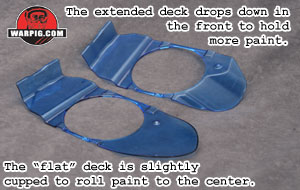 The flat-deck is, as its name implies, nearly flat. It is actually slightly bowed. Although it does not allow for quite as many paintballs to be carried in the loader, it doesn't have a pocket in the front. If a ball is in the loader, it will end up rolling to the catch-cup without the shooter having to ever break their stance to tip the loader. The trade off, is that with the flat deck, the loader's capacity is reduced by 10 to 20 paintballs. If anything, the extra holding capacity offered by the extended deck is similar to the reserve function on a motorcycle fuel tank. After shooting the hopper empty, rocking it back readies another 10 or so reserve shots before reloading. The flat-deck is, as its name implies, nearly flat. It is actually slightly bowed. Although it does not allow for quite as many paintballs to be carried in the loader, it doesn't have a pocket in the front. If a ball is in the loader, it will end up rolling to the catch-cup without the shooter having to ever break their stance to tip the loader. The trade off, is that with the flat deck, the loader's capacity is reduced by 10 to 20 paintballs. If anything, the extra holding capacity offered by the extended deck is similar to the reserve function on a motorcycle fuel tank. After shooting the hopper empty, rocking it back readies another 10 or so reserve shots before reloading.
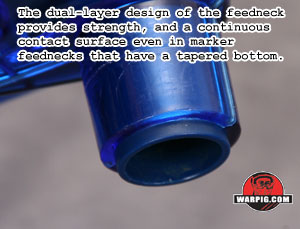 The loader's feedneck consists of two layers – one formed by the two halves of the loader shell, and one formed by the neck extending from the raceway inside. The inner neck is slightly longer, allowing it to sleeve into angle-bottomed feednecks on markers, in order to minimize any gap in the wall of the path the balls take into the marker. Even a small gap could potentially allow unwanted side to side movement of the paintball, leading to loading delays. The loader's feedneck consists of two layers – one formed by the two halves of the loader shell, and one formed by the neck extending from the raceway inside. The inner neck is slightly longer, allowing it to sleeve into angle-bottomed feednecks on markers, in order to minimize any gap in the wall of the path the balls take into the marker. Even a small gap could potentially allow unwanted side to side movement of the paintball, leading to loading delays.
Without sanding, the sample loader reviewed fit in a variety of both stock and aftermarket feednecks during review.
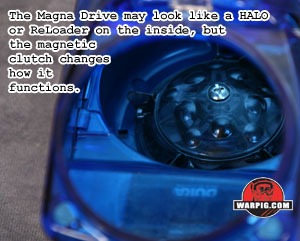 The heart of the Magna Drive Loader is its drive system. Although it may look very familiar, it has some significant differences from the HALO design. The heart of the Magna Drive Loader is its drive system. Although it may look very familiar, it has some significant differences from the HALO design.
The original and short-lived HALO loader was designed with a circular raceway, and a drive cone in the center. Short arms extending out of the drive cone pushed paintballs around the raceway, and out into the feedneck to feed the paintgun. The HALO used a gear drive system, and only applied force to the stack of paintballs in the feedneck when the motor was running. Worse yet, if it applied force to the stack when there wasn't room for the paintballs to feed, it could end up breaking paint.
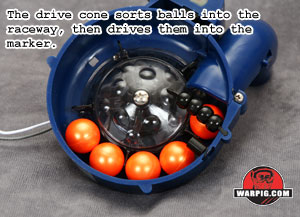 The HALO design was followed up by the HALO-B. While many believe the “B” signifies that it was the second model, following the HALO-A, the original HALO was not called HALO-A. The name HALO-B actually stems from the loader's drive mechanism. The gearing system in the HALO-B (and Reloader loaders based on it) has a belt drive. A large o-ring is used as a drive belt to carry force from the motor to one of the drive gears. According to designer Chris Goddard, this was so that if the paddles on the ball cone did meet with resistance, the drive belt could slip, instead of over-driving and breaking the paint. The HALO design was followed up by the HALO-B. While many believe the “B” signifies that it was the second model, following the HALO-A, the original HALO was not called HALO-A. The name HALO-B actually stems from the loader's drive mechanism. The gearing system in the HALO-B (and Reloader loaders based on it) has a belt drive. A large o-ring is used as a drive belt to carry force from the motor to one of the drive gears. According to designer Chris Goddard, this was so that if the paddles on the ball cone did meet with resistance, the drive belt could slip, instead of over-driving and breaking the paint.
 The other design innovation in the HALO-B was the spring loaded drive cone - arguably the secret to the loader's success. The belt and gear drive train did not link directly to the drive cone. Instead it linked to a wheel beneath the drive cone, that was connected to the drive cone by a torsion spring, allowing the drive train to turn as much as 345 degrees ahead of the drive cone. Because of this spring, the loader could provide a constant light pressure on the stack of paintballs, even when the motor was not running. The other design innovation in the HALO-B was the spring loaded drive cone - arguably the secret to the loader's success. The belt and gear drive train did not link directly to the drive cone. Instead it linked to a wheel beneath the drive cone, that was connected to the drive cone by a torsion spring, allowing the drive train to turn as much as 345 degrees ahead of the drive cone. Because of this spring, the loader could provide a constant light pressure on the stack of paintballs, even when the motor was not running.
The spring basically provided slack for motor timing – even if the motor did not start instantly when the marker was ready for a paintball, the spring would start the feeding process. If the motor didn't stop instantly when the ball-stack stopped moving, that was all right too, because the motor would just wind a little more pressure on the spring, instead of smashing paint.
In the years since the HALO-B's introduction, there has been a push for gentler paint handling, allowing serious players to use more fragile paintballs which are more likely to break on target. This can require a trade off though – it is hard to feed paint faster, while still handling it gently.
The new drive cone design of the Magna Drive adds a magnetic clutch system to the mix. Taking up the original concept of belt slippage in the HALO-B, the Magna Dive's belt drive system spins a carrier of magnets, which in turn spin a steel plate which winds the drive cone's torsion spring, pushing the stack of paintballs. If the motor spins while the stack of paintballs is not moving, the torsion spring winds, and when it reaches its limit, instead of overdriving the paint, the magnets are able to break their hold on the steel plate, and slip past, protecting the paint.
Much like the belt drive gave the HALO-B its name, the magnetic clutch inspired the name of the Magna Drive loader. The magnetic clutch system is also available as an upgrade for existing HALO or Reloader hoppers.
Additionally the top of the drive cone assembly is now separate from the side and drive paddles. It also features a number of rounded bumps. Because the top moves semi-independently of the paddles on the sides, the bumps on its surface serve to jostle and agitate paintballs, helping them get to the raceway where the paddles can drive them forward - even when the clutch is slipping and the drive paddles are still..
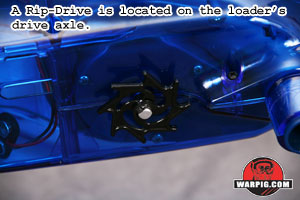 At the bottom of the loader's drive shaft, extending below the loader body is the Rip Drive wheel, a popular accessory for HALO and Reloader loaders. The Rip drive allows for manual tensioning of the torsion spring if the batteries or dead, or for tension to be relieved manually when taking the loader off of a marker. At the bottom of the loader's drive shaft, extending below the loader body is the Rip Drive wheel, a popular accessory for HALO and Reloader loaders. The Rip drive allows for manual tensioning of the torsion spring if the batteries or dead, or for tension to be relieved manually when taking the loader off of a marker.
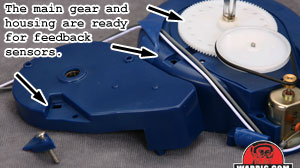 Worthy of note, the main gear of the drive system is ringed by holes. Additional holes in the feed raceway, and a small hatch over the main gear are well placed to allow the placement of optical sensors that could potentially be used for a future upgrade utilizing feedback sensors to improve performance. Worthy of note, the main gear of the drive system is ringed by holes. Additional holes in the feed raceway, and a small hatch over the main gear are well placed to allow the placement of optical sensors that could potentially be used for a future upgrade utilizing feedback sensors to improve performance.
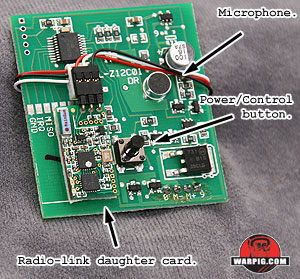 Like Reloaders, the Magna Drive uses sound to know when it needs to activate. A microphone on the loader's circuit board detects the sharp sound of a marker firing, and pulses the motor to advance the drive cone, maintaining tension on the torsion spring as paint is fed. An optional radio-frequency link, requiring a transmitter that may be installed in a marker, bypasses the sound activation system altogether. Which-ever method is used, the Magna Drive loader does not have any internal “eye” systems – there are no infra-red break-beam or reflection systems used. Like Reloaders, the Magna Drive uses sound to know when it needs to activate. A microphone on the loader's circuit board detects the sharp sound of a marker firing, and pulses the motor to advance the drive cone, maintaining tension on the torsion spring as paint is fed. An optional radio-frequency link, requiring a transmitter that may be installed in a marker, bypasses the sound activation system altogether. Which-ever method is used, the Magna Drive loader does not have any internal “eye” systems – there are no infra-red break-beam or reflection systems used.
Continue on to Page 2
|




